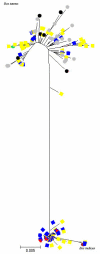Revealing fine scale subpopulation structure in the Vietnamese H'Mong cattle breed for conservation purposes
- PMID: 20525403
- PMCID: PMC2889845
- DOI: 10.1186/1471-2156-11-45
Revealing fine scale subpopulation structure in the Vietnamese H'Mong cattle breed for conservation purposes
Abstract
Background: During the last decades, there has been an acceleration of the loss of domestic animal biodiversity. For conservation purposes, the genetic diversity of the H'Mong cattle, an indigenous local breed was studied. Single-nucleotide polymorphisms (SNP) of the SRY gene and mtDNA D-Loop sequence were analysed to clarify the origin of the breed. The genetic diversity was assessed through genetic data with twenty-five FAO microsatellites, and morphometric data with five body measurements from 408 animals sampled from eight districts of the Ha Giang province.
Results: The SRY genes were all of the zebu type. Among the 27 mtDNA haplotypes, 12 haplotypes were of the taurine type and the remaining 15 of the zebu type. This indicates female taurine introgression in the zebu H'Mong. The observed and expected heterozygosity ranged from 0.616 to 0.673 and from 0.681 to 0.729 respectively according to district, with low genetic differentiation (F ST = 0.0076). Multivariate analysis on morphometric and genetic data shows a separation of districts into two groups following a south-west/north-east cline and admixture analysis confirmed the two clusters, but no differentiation of taurine introgression between clusters was observed. A possible admixture with the Yellow cattle breed from a neighbouring province was suggested through genetic data and householder interviews.
Conclusions: In this study we demonstrate the interest of fine-scale sampling for the study of genetic structure of local breeds. Such a study allows avoiding erroneous conservation policies and on the contrary, proposes measures for conserving and limiting crossbreeding between the H'Mong and the Yellow cattle breeds.
Figures





Similar articles
-
Uncontrolled admixture and loss of genetic diversity in a local Vietnamese pig breed.Ecol Evol. 2012 May;2(5):962-75. doi: 10.1002/ece3.229. Ecol Evol. 2012. PMID: 22837841 Free PMC article.
-
Genetic analysis of local Vietnamese chickens provides evidence of gene flow from wild to domestic populations.BMC Genet. 2009 Jan 8;10:1. doi: 10.1186/1471-2156-10-1. BMC Genet. 2009. PMID: 19133138 Free PMC article.
-
Genetic diversity, introgression and relationships among West/Central African cattle breeds.Genet Sel Evol. 2004 Nov-Dec;36(6):673-90. doi: 10.1186/1297-9686-36-6-673. Genet Sel Evol. 2004. PMID: 15496287 Free PMC article.
-
Revisiting AFLP fingerprinting for an unbiased assessment of genetic structure and differentiation of taurine and zebu cattle.BMC Genet. 2014 Apr 17;15:47. doi: 10.1186/1471-2156-15-47. BMC Genet. 2014. PMID: 24739206 Free PMC article.
-
Evolution and domestication of the Bovini species.Anim Genet. 2020 Oct;51(5):637-657. doi: 10.1111/age.12974. Epub 2020 Jul 27. Anim Genet. 2020. PMID: 32716565 Review.
Cited by
-
Conservation genomic analysis of domestic and wild pig populations from the Iberian Peninsula.BMC Genet. 2013 Oct 30;14:106. doi: 10.1186/1471-2156-14-106. BMC Genet. 2013. PMID: 24172017 Free PMC article.
-
Uncontrolled admixture and loss of genetic diversity in a local Vietnamese pig breed.Ecol Evol. 2012 May;2(5):962-75. doi: 10.1002/ece3.229. Ecol Evol. 2012. PMID: 22837841 Free PMC article.
-
mtDNA Diversity and Phylogenetic State of Korean Cattle Breed, Chikso.Asian-Australas J Anim Sci. 2013 Feb;26(2):163-70. doi: 10.5713/ajas.2012.12499. Asian-Australas J Anim Sci. 2013. PMID: 25049772 Free PMC article.
-
Mitochondrial DNA diversity of the Sardinian local cattle stock.Sci Rep. 2022 Feb 15;12(1):2486. doi: 10.1038/s41598-022-06420-3. Sci Rep. 2022. PMID: 35169207 Free PMC article.
-
An Overview of the Use of Genotyping Techniques for Assessing Genetic Diversity in Local Farm Animal Breeds.Animals (Basel). 2021 Jul 6;11(7):2016. doi: 10.3390/ani11072016. Animals (Basel). 2021. PMID: 34359144 Free PMC article. Review.
References
-
- Scherf BD. World Watch List for Domestic Animal Diversity, 3rd eds. 3. Food and Agriculture Organization of the United Unions, Rome; 2000.
-
- Vo Van S. At lat: cac giong vat nuoi o Viet Nam "Atlas: animal domestic breeds of Vietnam". Nha xuat ban nong nghiep - Hanoi (in Vietnamese); 2004.
-
- Zhang GX, Wang ZG, Chen WS, Wu CX, Han X, Chang H, Zan LS, Li RL, Wang JH, Song WT, Xu GF, Yang HJ, Luo YF. Genetic diversity and population structure of indigenous yellow cattle breeds of China using 30 microsatellite markers. Anim Genet. 2007;38:550–559. - PubMed
Publication types
MeSH terms
Substances
LinkOut - more resources
Full Text Sources

